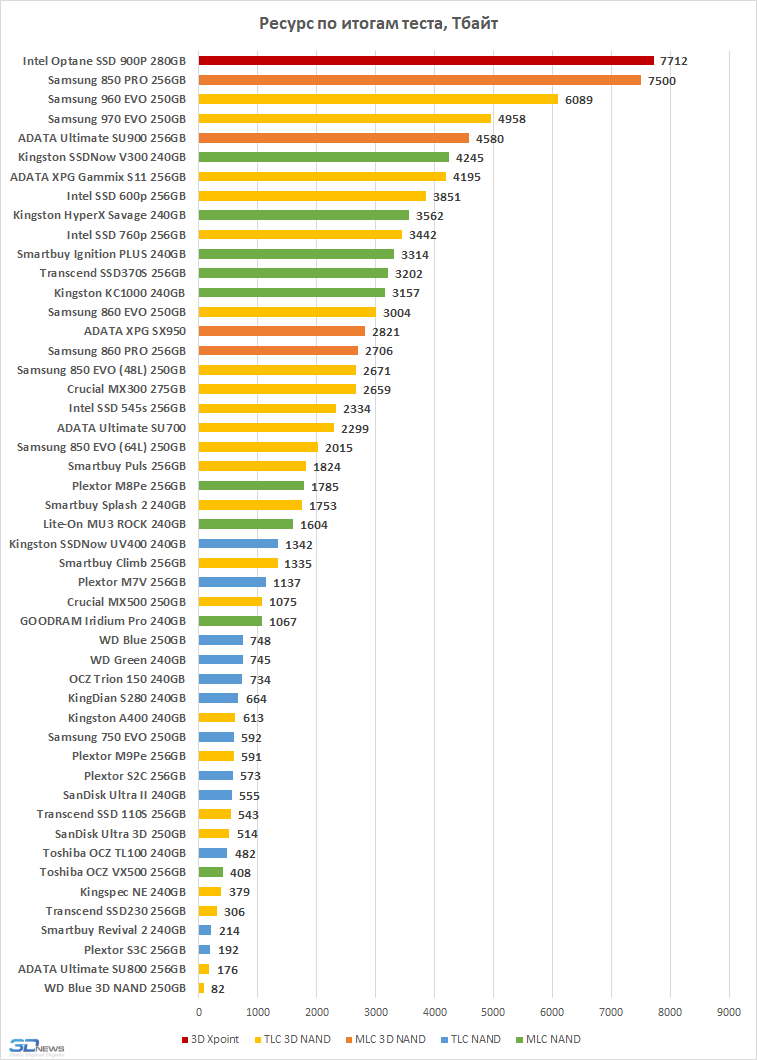Aiemmin sanoit etteivät kaikki ilmoita SMART arvoja välttämättä samalla tavalla

Eri valmistajat eivät välttämättä ilmoita SMART-arvoja samalla tavalla, joten tilanne kannattaa erikseen tarkistaa jokaisen valmistajan kohdalla heidän itsensä tarjoamista spekseistä...
Mikään ei viittaa siihen että tuo olisi kovinkaan kallis asema.
Tuo on asema, jota ei myyty retail-kanaviin, minkä vuoksi mahdollista retail-hintaa on vaikea arvioida.
Retail-hinnoittelu kun poikkeaa varsin usein merkittävästi OEM-hinnoittelusta.
Hyvä asemahan tuo oli tuoden mukanaan uusia teknisiä innovaatioita, joiden avulla 2D MLC NANDia käyttävien SSD-asemien kirjoituskestävyyttä pystyttiin parantamaan merkittävästi, vaikka itse NAND ei ollutkaan sen kestävämpää kuin vastaavissa 72 TBW luokituksen saaneissa Crucialeissa.
Lue pelkästään otsikko niin ehkä ymmärrät.

Esitätkö lainauksistasi kohdan jossa sanotaan tuossa olevan SLC NAND:a?
Tavaappa seuraava huolella:
Micron's M600 solid-state drive reviewed
Micron's 16-nm NAND can switch between SLC and MLC modes on the fly. The MX100 doesn't take advantage of this capability, but in the M600, custom firmware manages the transitions at the block level.
There's another potential fly in the ointment, though. Any cached data that makes its way to MLC storage will be written twice, eating into the NAND's limited endurance. Fortunately, SLC writes are less damaging than MLC ones. Micron has also adjusted "proprietary NAND trims" to offset the endurance penalty associated with write caching. These top-secret settings are "configured during the NAND fabrication process," and they can be "tuned for different performance and endurance characteristics." Despite the name, they're unrelated to the TRIM command used by the operating system to identify deleted data.
Tweaking NAND trims is apparently quite effective, because the M600 has the most impressive endurance ratings we've seen in a client-oriented SSD. Micron's other drives in this category are specced for 72TB of total writes, and so are their Crucial cousins.
Kuten useimmat kuitenkin varmaan ymmärtävät, yllä olevan arvion mukaan olennaisin kestoon vaikuttava innovaatio oli: "proprietary NAND trims". Eli sikäli voit unohtaa vaikka kokonaan nuo SLC:hen viittaavat kohdat...
Aivan sama onko asiantuntijalähteitä vai ei, ellei niistä ymmärrä tarpeeksi.
No se on kyllä huomattu, ettet ymmärrä.
"Todelliseksi huippuasiantuntijaksi" kyseinen henkilö on kunnostautunut lähinnä Samsungin kehujana, joten ei pahemmin herätä arvostusta.
Esim. näin sanoo "todellinen huippuasiantuntija" yhdestä 2010-luvun huonoimmasta SSD-mallisarjasta:
Lue tuon jälkeen se otsikko uudelleen niin ymmärrät mitä tarkoitan.
Samsung on ollut uusien SSD-tekniikoiden markkinoilletuojana usein edellä muita, kuten useimmat alaa seuraavat varmasti tietävät. Niin myös tuon mallin osalta arvosteluhetkellä saatavilla olevan testidatan ja speksien perusteella, joten sikäli väittämä on ymmärrettävä.
On turhaa jälkiviisastella myöhemmin ilmenneillä bugeilla - varsinkin, kun tuon jälkeen on sekä Samsungin että muiden valmistajien toimesta julkaistu ongelmitta toimivia TLC:tä käyttäviä SSD-asemia.
Jälkikäteen on toki selvää, että Samsung toi 2D TLC-pohjaiset ratkaisunsa liian varhain markkinoille. Mutta turha tässä vaiheessa on enää sinun tapaasi jumittaa johonkin vuosia sitten julkaistuun SSD-asemaan...
Anandtechille ja
MUROPAKETTIinkin aikoinaan kirjoittanut Kristian Vättö on SSD-asemien todellinen huippuasiantuntija, joka osaa helppolukuisesti ja uskottavasti kertoa myös teknisesti haastavistakin aiheista.
Aivan kuten Samsungin kohdalla, hän on ylistänyt myös bugin riivaamaksi osoittautunutta Crucialin SSD-asemaa:
Crucial MX100 (256GB & 512GB) Review
All in all, I have nothing negative to say about the MX100. With the performance and feature set, combined with pricing that basically doubles the amount of storage you get for your dollar, it's an absolute no-brainer. Unless you are an enthusiast or professional with a heavy IO workload, the MX100 is currently the drive with the best bang for the buck in the market by far.
The MX100 was a revolutionary product in many ways. It was the first drive to move to sub-19nm NAND, which brought cost savings along with it. The combination of price and performance made the MX100 arguably one of the most cost efficient drives on the market.
It comes as no surprise that the BX100 is very competitive in price. The Ultra II and SSD370 are slightly cheaper, but neither of them can provide the same combination of performance and power efficiency as the BX100 does. On that basis I would pick the BX100 over the two since the price delta is rather insignificant anyway (and obviously, pricing fluctuates on a daily and retailer basis). The 850 EVO is also very close in price and offers a little higher performance, but it can't challenge the BX100 in power efficiency, so for mobile users my recommendation would be the BX100, whereas the 850 EVO does offer marginally better value for desktop users.
Myös Sandiskin SSD-asemat ovat saaneet häneltä ylistäviä arvioita:
SanDisk Extreme Pro SSD (240GB, 480GB & 960GB) Review: The Fastest Just Got Faster
The Extreme Pro is without a doubt the fastest SATA 6Gbps SSD in the market. As Anand said in the
Extreme II review, SanDisk has picked an excellent balance of IO consistency and peak performance, resulting in high performance regardless of the workload.
...
All in all, the Extreme Pro is the only no compromise high-end SSD in the market (aside from the Extreme II, of course). Its performance is unmatched by any other SATA 6Gbps drive and it is the only truly high performance SSD with proper power management, making it perfect for mobile use as well.
Kuten esimerkit osoittavat, väitteesi siitä, että "
kyseinen henkilö on kunnostautunut lähinnä Samsungin kehujana" ei pidä paikkaansa!
Miksi valehtelet ja yrität tekaistujen väittämien avulla mustamaalata kyseistä henkilöä?
Todella alhaista toimintaa!









